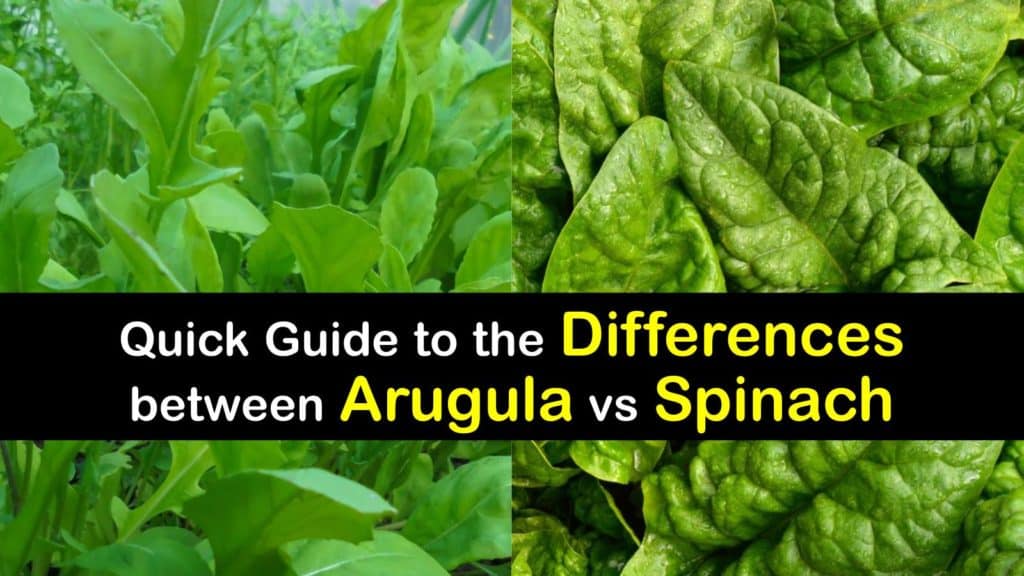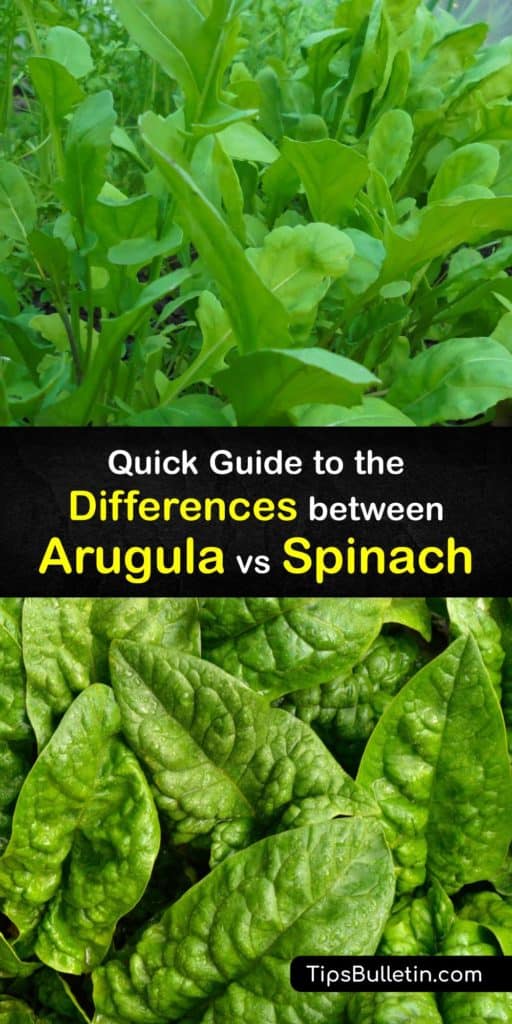We love our salad greens, and we’re always in search of the next superfood. Spinach used to be revered as the most nutritious leafy green until arugula made its appearance. Many wonder what’s the difference between arugula vs spinach and which one has more health benefits.
Many different leafy green vegetables are an excellent addition to the diet, from iceberg lettuce, romaine lettuce, rucola, and watercress to Swiss chard, collard greens, baby spinach, and arugula leaves. However, some are more nutritious than others, and they vary in flavor and texture.
Arugula and other leafy greens are the tastiest raw, and others like spinach are perfect for cooking in a side dish.

Difference between Spinach and Arugula
While both arugula and spinach are simple to grow at home, there are different varieties of each, and their taste and nutritional value vary. It’s helpful to understand their differences before incorporating them into your garden and diet.
There is nothing better than tossing greens in a garden salad or cooking in omelets to add a healthy kick to your food. However, picking the best one for your next meal is confusing with so many leafy green choices. What is arugula, and how does it differ from spinach?
Learn the flavor and nutritional difference between arugula and spinach and the different varieties to help you choose the ideal vegetable for your dietary needs. Find out how to grow them in your home garden and a recipe that combines their goodness in one dish.
What is Arugula, and How is It Different than Spinach?
We are all familiar with leafy greens like iceberg, romaine, and butterhead lettuce varieties since these are popular choices for making a salad with cucumbers and tomatoes. But, what is arugula, and is it similar to spinach?
Arugula (Eruca sativa) is an annual native to the Mediterranean region, and it goes by other names, including garden rocket, roquette, and rocket salad. It is one of many cruciferous vegetables, a part of the Brassica genus of plants.

Spinach (Spinacia oleracea) comes from central and southwest Asia, is widely grown throughout the United States, and is not considered a cruciferous vegetable.
Spinach leaves are darker in color than arugula, as well as denser and thicker. It grows anywhere from six inches to a foot or taller, depending on the type, with leaves that are wide and oval-shaped.
Arugula leaves grow six to twelve inches tall and are elongated with ridges. Both leafy greens are capable of regrowing after a harvest if you cut them back properly.
There are three main varieties of spinach – savoy, semi-savoy, and flat or smooth leaf spinach, while the two different types of arugula are wild Italian arugula and common arugula.
The Flavor Difference between Arugula vs Spinach
What is the flavor difference between spinach and arugula, and can you substitute arugula for spinach? Discover how these two leafy greens differ in taste and some substitutes for cooking and eating fresh.
Raw spinach has a somewhat sweet, mild flavor and is a refreshing topping on sandwiches and salads. Cooking spinach makes the taste more robust and acidic.
Raw arugula has a bright, slightly bitter, or peppery flavor that makes them distinct from other leafy greens, and the flavor becomes more intense as the leaves mature. Cooking the leaves sometimes brings out nuances of mustard and nuts.
Arugula and spinach are suitable replacements for each other in both raw and cooked dishes. Other great substitutes and spinach alternatives for these greens are Swiss chard, beet greens, turnip greens, kale, watercress, and any dark green lettuces.
Nutritional Difference between Arugula and Spinach
All leafy greens are good for you, and eating them provides you with the necessary vitamins and minerals. However, there is a difference between arugula and spinach in nutrition, like with mustard greens vs kale. Explore whether one is healthier than the other.
Since spinach is denser than arugula, it fills less volume for the same weight. Five cups of arugula and three and a half cups of spinach have similar calories, fiber, protein, and vitamin A.
However, spinach has more potassium and magnesium and considerably more vitamin C, vitamin K, folate, oxalate, manganese, and iron, while arugula contains more calcium.
Both plants are low in carbohydrates and contain antioxidants, glucosinolates, micronutrients, and beta-carotene, and are good for weight loss, eye health and bone health, and lowering cholesterol and blood pressure.
When considering the total amount of vitamins and minerals, spinach is healthier than arugula, although it tends to cause digestive side effects in sensitive people.
Are Spinach and Arugula Plants Easy to Grow?
If you’re a vegetable-lover, then growing arugula from seed or spinach is the best way to get the freshest veggies without all the unnecessary chemicals. Fortunately, both spinach and arugula are easy growers, and all you need are some seeds, a pot of soil, and our helpful gardening tips to get started.
Sprouting spinach seedlings and arugula seedlings is simple and satisfying. Try both for a little variety.
Arugula and spinach are cold-hardy plants that tolerate early spring planting. Arugula is hardy in zones 3 through 11, and spinach prefers growing in USDA hardiness zones 5 through 10.
Sow the seeds outdoors as soon as you can work the dirt in the early spring. Prepare the garden bed with aged manure a week before planting. Plant arugula seeds a quarter-inch deep and sow spinach seeds a half-inch to an inch deep in the soil.
How far apart to plant spinach and arugula is equally important for them to thrive. Water right after planting and thin arugula seedlings to six inches apart and spinach to four inches apart after they start growing. Water your plants regularly and mulch the bed or container to retain moisture.
Keep an eye out for flea beetles, leaf miners, and other garden pests, and apply insecticidal soap if necessary. When the leafy greens reach the desired size, harvest the entire plant at once or pick the leaves a layer at a time to encourage inner layers to develop.
Harvest baby spinach or regular spinach as well as arugula when they grow big enough to use.
How to Make Pesto with Arugula and Spinach
While we often associate pesto with basil, arugula and spinach are great alternatives for making this sauce. It takes ten minutes to prepare and is perfect as a pizza topping or slathered on grilled meats.
Pour the walnuts into a dry saute pan and toast them over medium-low heat for a few minutes. Pour the nuts into a food processor, along with the lemon zest and juice, arugula, spinach, garlic cloves, olive oil, salt, and pepper.
Pulse to combine the ingredients and then switch to high speed while pausing to scrape down the sides as needed. Pour the pesto into an airtight container and store it in the fridge for up to five days.
Using Spinach and Arugula in a Recipe
If you’re searching for a simple side dish that combines the flavor of arugula and spinach, look no further. This rigatoni pasta dish is a tasty recipe that brings the two leafy greens together for the perfect blend.
Follow the pasta instructions, cook the rigatoni until al dente, and drain the pasta. Heat the olive oil in a skillet on medium heat and cook the onion and red pepper flakes while stirring for about six minutes. Add the minced garlic, cook for one minute, and add the butter and lemon juice.
Remove the skillet from the stove and whisk the ingredients until combined. Pour in the drained and cooked pasta, pine nuts, spinach, and arugula. Toss everything together and add pepper and salt to taste. Spoon servings into bowls and top with grated Parmesan and lemon zest.
Arugula and spinach are great additions to the diet, and they are both easy-growers. However, their flavor is unique, and the amount of vitamins and minerals varies. Whichever leafy green you pick as your next favorite, your garden and dinner plate are bound to be pleasing.

Now that you know the key differences between arugula vs spinach to help you decide which one is perfect for your tastes and health, why not share our spinach vs arugula guide with the veggie-lovers in your life on Pinterest and Facebook?